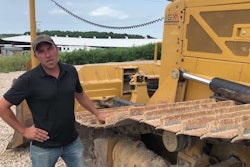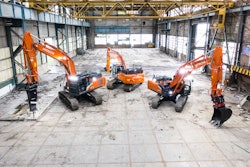
Heavy equipment and parts are in short supply, inventories are low, and prices have been escalating for two years. Most people blame Covid-19, but Benjamin Duyck, director of market intelligence at the Association of Equipment Manufacturers, says the virus is not the only problem.
 Benjamin Duyck, director of market intelligence, Association of Equipment Manufacturers (AEM)Association of Equipment Manufacturers
Benjamin Duyck, director of market intelligence, Association of Equipment Manufacturers (AEM)Association of Equipment Manufacturers
The supply chain issues have been building for a long time, says Duyck. “Covid-19 was just an unforeseen shock that exposed larger, ongoing trends.” The confluence of these trends created the perfect storm as Covid hit in early 2020. The trends include a shrinking workforce, supply chain bottlenecks, higher than expected demand and an expansionary monetary policy.
“More than 95% of our AEM members are experiencing supply chain issues,” says Duyck. “For 70% of the OEMs, these issues are getting worse. On the component side, about 45% are having issues.”
Where are the workers?
Some of the depletion in the workforce is a result of Covid-19, says Duyck, but the larger trend of a shrinking labor pool has been an issue for more than a decade.
“It’s clear that hiring is a strain on our industries,” he says. “It’s a little bit more of an issue on the manufacturing floor rather than the office. On the office side, we see improvements over time.”
Bottlenecks
“Given the widespread nature of supply chains, bottlenecks are not only endemic to our industries but to the global economy as well,” says Duyck. Some of the bottlenecks equipment manufacturers are experiencing include:
1. Depleted inventories. “That’s the number one thing we see in our member surveys,” says Duyck. “On the agricultural equipment side, several categories are depleted all the way back to 2010 levels. It’s not just the inventory of equipment but the materials in the supply chain. This leads to difficult choices for component manufacturers.”
2. International shipping. “When you have a shock like Covid-19 it can disrupt the way the global supply chain works,” says Duyck. “You have difficulties coordinating international shipping and container shortages.”
3. Demand. Supply chains were caught on the wrong side of the demand curve, cutting back on production as demand accelerated. “On the construction equipment side, demand was much higher than expected,” says Duyck. “The recovery was very fast. And there was a pent-up demand for machinery.” Demand was up 10% to 15% in 2021 and this was 6% to 10% higher than expected. In a survey of AEM members, 91% believe the market will continue to grow in similar fashion.
4. Inflation. “Prices for raw materials are increasing for a myriad of reasons, but most obviously because demand is so much higher than expected,” says Duyck. “At the same time, we are experiencing an expansionary monetary policy that’s increasing the money supply. That not only increases the price of components and equipment, but for construction it increases mortgage rates and loan costs. We’re seeing inflation rates that are the highest since the mid-1980s. For construction machinery manufacturing in 2021, inflation was about 4.6% for the whole year, but it got worse toward the end of the year. And in December year-over-year it was 9.7%.”
Missing production
Equipment and component production grew 5% to 10% in 2021, says Duyck.
“When we asked members how much they could have grown without supply-chain issues, a lot of them said 15% to 20%. For 2022, the same growth is expected. So this tells me there is a large chunk of production growth missing due to supply-chain issues.”
In addition to rising prices, all these issues are stretching out lead times. “On average the OEMs' lead times have almost tripled since 2019, and that’s a trend that’s increasing,” says Duyck. “That’s gone from a three-month lead time for a piece of equipment all the way to eight and a half months.”
Tackling the challenge
So what are OEM and component manufacturers doing about all these problems? Duyck sees several developments:
- Increasing and improving communications throughout the supply chain for better supply-chain signaling.
- Increasing the supplier base — sourcing from a lot more areas and increasing the stock they have of parts and equipment inventories.
- On-boarding new suppliers faster and more efficiently.
- More investments in analytics up and down the supply chain.
- Bringing manufacturing back. Large increases in on-shoring and re-shoring manufacturing will take some of the global risks out of the supply chain.
Tech, the unsung hero
Telematics is also playing a quiet but effective role in mitigating the impact of the supply chain crisis for end users and manufacturers.
Aggregated insights provided by machine intelligence improves equipment longevity and reduces unplanned downtime, says Duyck. Telematics data can also help end users decide more accurately if and when they need to buy more equipment or when they should rent. In similar fashion equipment dealers and OEMs can parse the data and spot trends in use before the trends become shortages or problems.
Part 2: Untangling the Supply Chain Crisis: The Dealer Perspective
Part 3: Untangling the Supply Chain Crisis: How Can Contractors Come Out Ahead











